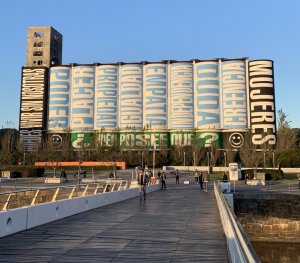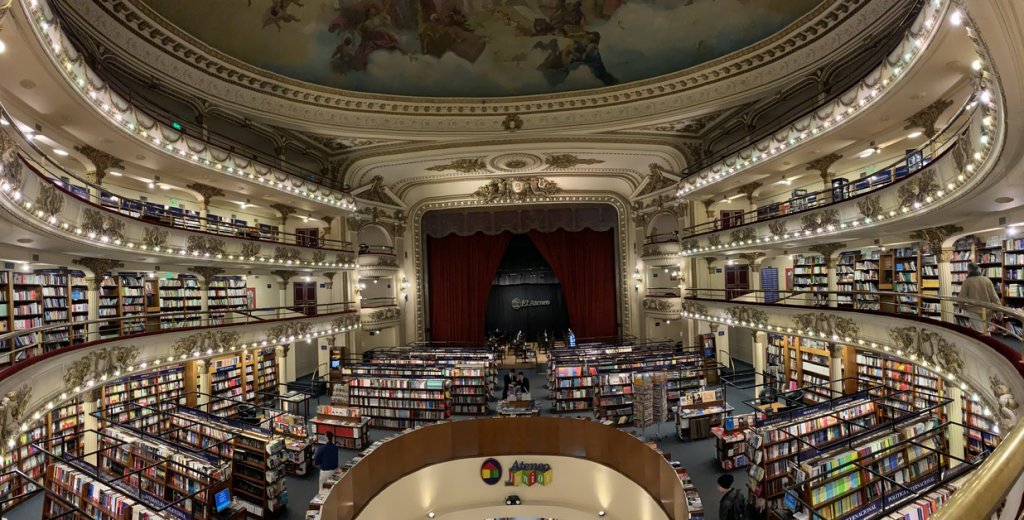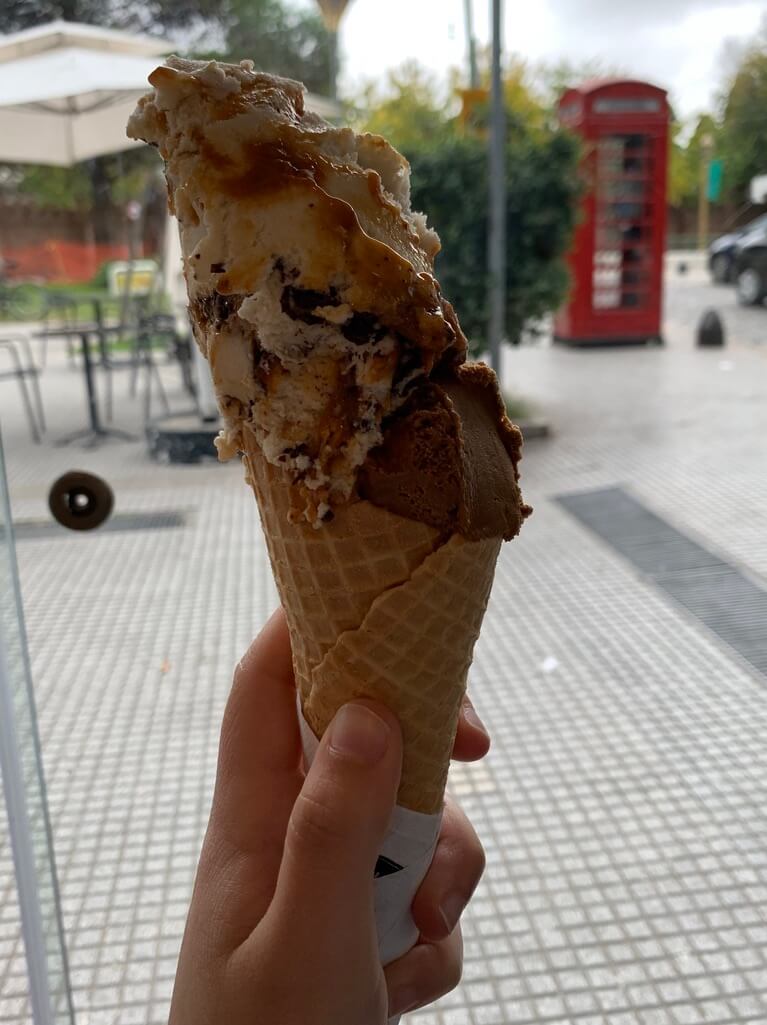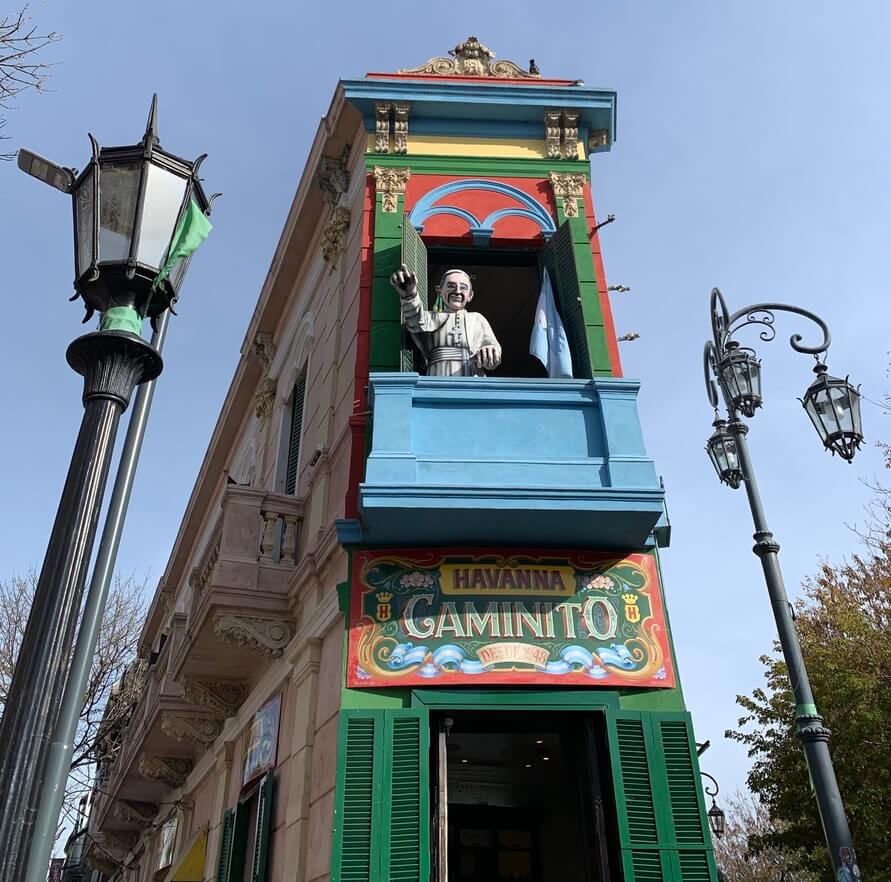Buenos Aires is one of our favorite cities in the world, and it’ll definitely capture your heart, too. Sprawling, tree-lined boulevards bisect gorgeous parks and squares, and romantic architecture surrounds you everywhere you go in this beautiful southern capital city. The music, food, and culture here are just sublime, and this guide to 3 days in Buenos Aires will give you the best tips to dive right in.
Tegan visited Buenos Aires more recently than Alex, as the 2nd leg of a whirlwind 3-week mom-and-daughter trip with her mom and sister Nicole. Other trip highlights included a weekend in Montevideo + Punta del Este, Uruguay, the Argentine Patagonia, Santiago + Valparaiso, Chile, and the Atacama Desert!
Day 1:
Table of Contents
ToggleWe arrived close to lunchtime on the Buquebus ferry from Montevideo. For all our tips on how to make the most of this experience stress-free, make sure to visit our how-to book your ferry guide. The ferry drops you off in the Puerto Madero area, which is definitely a must-visit part of town, but we opted to table our exploration for a later date since we had our big backpacks with us. Side note: believe it or not, backpacks were the only thing we brought on this 3-week trip. We LOVE our Patagonia Black Hole 55L duffel bags for travel. They’re super spacious, but also fit within (most) airlines’ carry-on restrictions. It feels so liberating to not have to roll a suitcase on a long trip, though take this with a grain of salt if you have a bad back, for sure. Paired with our beloved Fjallraven Kanken daypacks, we felt unstoppable. Since we wanted to drop off our things and buy some groceries for lunch, we took an Uber to our Airbnb in Palermo Hollywood.
There are a ton of great places to stay in Buenos Aires. We chose the Palermo neighborhood, and specifically Palermo Hollywood, because it was recommended by Argentine friends and was a budget area that still felt very safe for 3 women travelers. We rented a full apartment on Airbnb that was a bit spartan, but fit well into our budget at $41 USD each night and was located in a very central part of Palermo.
We spent most of our first afternoon exploring the Bosque de Palermo and Parque 3 de febrero, two lovely parks near our Airbnb, and grabbing a quick bite to eat in the Arcos del Rosedal area nearby. This is a super neat converted train track that now houses boutiques, restaurants, and some nightlife in the arches underneath. It’s not cheap, but is considered one of the most hip new places to eat and walk around in Buenos Aires, so it’s definitely worth checking out.
After lunch, we walked around the San Telmo neighborhood, which is the oldest neighborhood in Buenos Aires. This was Tegan’s favorite part of the city for its vintage storefronts, curious and whimsical indoor market, and romantic plazas. 
Make sure you pop into one of Havanna’s many locations to try alfajores (a type of soft cookie filled with dulce de leche, a type of caramel.) There are also delicious little cones filled with dulce de leche to try called havannets. Note: we specifically mention Havanna here because we took it upon ourselves to try every alfajor brand we could find in shops and grocery stores in both Argentina and Uruguay (you’re welcome, happy to be of service in this area.) From this hard work and research, we concluded that Havanna is the best brand, without a doubt. Alfajores are a treat that Tegan pines for on a regular basis– have any of you found them in the U.S.? Is there a brand other than Havanna that you prefer? Let us know in the comments, and join us in hoping that heaven consists of alfajores and a tub of dulce de leche that never ends.
From San Telmo it’s a quick 6 blocks to the Plaza de Mayo, the center of all things government and social justice in Buenos Aires. The Plaza de Mayo is famous for a variety of reasons. It’s the oldest square in the city, and the city was founded (for the second time) here in 1580.
The plaza is named after the Argentine revolution for independence, which took place on May 25, 1810, and the country’s first political rally took place here in 1890. The plaza has seen countless rallies since then. Perhaps most famously, huge crowds gathered here to hear Eva (Evita) Perón speak from the balcony of the Casa Rosada in the late 1940s, and Las Madres de la Plaza de Mayo (the Mothers of the Plaza de Mayo), began meeting here in 1977 to demand answers about their missing children and other desaparecidos (or “disappeared”) during Argentina’s last military dictatorship. These mothers actually still meet in the plaza every Thursday at 3:30PM today– and sadly, most of the desaparecidos were never found.
Madonna’s Evita is certainly an overdramatization, but a thought-provoking movie to watch prior to your visit, as Evita is everywhere in Argentina. There’s even a controversial law that the faces or names of prior leaders can’t be removed from buildings.
There are a lot of things to see around the Plaza, including the Cabildo (the seat of city government), the Casa Rosada (the executive mansion/office of the President), the Metropolitan Cathedral, the Argentine National Bank headquarters, and the Palacio de Hacienda (the seat of various ministries.) The architecture around the Plaza is super striking and worth exploring.
 Just before sunset, we culminated our sightseeing for the day back in Puerto Madero, which is very close to the Plaza de Mayo and San Telmo areas. Puerto Madero is a recently revamped waterfront area with tons of restaurants, bars, and nightlife, as well as the Puente de la Mujer, a bridge by Spanish architect Santiago Calatrava dedicated to Argentine women through history. Its abstract design is supposed to reflect a man and woman dancing tango. Puerto Madero used to serve as the commercial port of Buenos Aires, and you can still walk all around the docks here, though they are now surrounded by sleek high-rises and very expensive lodging and restaurant options.
Just before sunset, we culminated our sightseeing for the day back in Puerto Madero, which is very close to the Plaza de Mayo and San Telmo areas. Puerto Madero is a recently revamped waterfront area with tons of restaurants, bars, and nightlife, as well as the Puente de la Mujer, a bridge by Spanish architect Santiago Calatrava dedicated to Argentine women through history. Its abstract design is supposed to reflect a man and woman dancing tango. Puerto Madero used to serve as the commercial port of Buenos Aires, and you can still walk all around the docks here, though they are now surrounded by sleek high-rises and very expensive lodging and restaurant options.
Day 2:
First thing in the morning, make a beeline for El Ateneo Grand Splendid in the Recoleta area, National Geographic’s top contender for “world’s most beautiful bookstore.” We agree! The Grand Splendid Theatre opened in 1919, hosting operas, ballets, recording studios, and even a radio station. In 2000, the struggling theatre was converted into a bookstore, with all stylistic components, including original frescoes, left intact. Today it serves as a bookstore, meeting place, and cafe. It gets very crowded, but we had it all to ourselves when we arrived at 9AM (daily opening time.)

From the Ateneo it’s an easy walk to the meeting point at the Corner of Libertad and Viamonte, next to Teatro Colon for a 10:30 AM free walking tour of the Recoleta neighborhood. Hosted by Buenos Aires Free Walks, the tour lasts about 3 1/2 hours and is chock-full of information and sightseeing. If you’re having trouble finding the meeting point, just look for folks in orange t-shirts– they’re nearly impossible to miss. You don’t have to book your tour, you can just show up and join the fun. This tour is another example of a tip tour, which we love to promote at Why Not Walk. Tip tours are a great way to learn about a place you’re visiting when you first arrive, and you just tip at the end. If you can’t make the morning Recoleta tour, there is also an afternoon tour of the city center, comprising many of the areas we visited on Day 1. The Recoleta tour included:
- Teatro Colón
- Avenida 9 de Julio
- Intro to Argentina’s aristocratic families and their palaces
- San Martín & Argentine War for Independence
- The Big Ben of South America
- Plaza San Martín
- History of the Malvinas War (or Falklands War)
- “Fancy Buenos Aires” and the Retiro neighborhood
- Colonial Franciscan Convent
- Introduction to Recoleta Cemetery
The tour drops you off right in front of the Recoleta Cemetery, which is an absolute must-see in Buenos Aires (photo above center). We know cemeteries aren’t everyone’s cup of tea, but this one is absolutely astounding. The architecture of the mausoleums and sheer breadth of winding alleyways to explore is really something. You can also see Evita’s grave here, where she is buried with the Duarte family. Buenos Aires Free Walks offers a paid tour of the cemetery for about $10 USD, but we opted to explore ourselves.
 From there, it’s fun to continue exploring the Recoleta area, which is arguably the most famous neighborhood in Buenos Aires. We stopped at an ice cream place called Freddo for (you guessed it) dulce de leche ice cream. Dulce de leche is a flavor option everywhere in Argentina for sweet treats, and we couldn’t be happier about that! We definitely recommend trying Argentine ice cream. It’s sort of like Italian gelato (there are a lot of Italian influences on Argentine food and desserts), but so, so creamy. You won’t regret it.
From there, it’s fun to continue exploring the Recoleta area, which is arguably the most famous neighborhood in Buenos Aires. We stopped at an ice cream place called Freddo for (you guessed it) dulce de leche ice cream. Dulce de leche is a flavor option everywhere in Argentina for sweet treats, and we couldn’t be happier about that! We definitely recommend trying Argentine ice cream. It’s sort of like Italian gelato (there are a lot of Italian influences on Argentine food and desserts), but so, so creamy. You won’t regret it.
Day 3:
 Buenos Aires Free Walks also offers a paid tour of the Caminito and La Boca areas of Buenos Aires at 11AM each day. It costs about $10 USD per person, which is well worth it for this tour. We normally don’t participate in paid tours, but we heard from Argentine friends that the area around Caminito is not very safe, and not recommended to walk around alone. If you don’t opt to do a tour, we were told to make sure you visit during the daytime and avoid exploring beyond the Boca Juniors stadium area.
Buenos Aires Free Walks also offers a paid tour of the Caminito and La Boca areas of Buenos Aires at 11AM each day. It costs about $10 USD per person, which is well worth it for this tour. We normally don’t participate in paid tours, but we heard from Argentine friends that the area around Caminito is not very safe, and not recommended to walk around alone. If you don’t opt to do a tour, we were told to make sure you visit during the daytime and avoid exploring beyond the Boca Juniors stadium area.
If you do decide to do the tour, it lasts about 2 hours, and the meeting point is easy to find: at the corner of Magallanes and Caminito, right outside the Havanna Shop (yum!)
The tour will walk you through the neighborhood, and is super informative. You’ll learn all about:
- The beautiful colorful houses, or conventillos, on the Caminito
- A brief history of tango, born here!
- A walk around the old industrial port area
- A guide to the fileteado style of art, murals, and street art
- History of Argentine immigration practices
- Boca Juniors Stadium, where Argentina’s most popular soccer club (and one of the most famous in the world), plays
The tour ends at the Boca Juniors stadium, and you can walk back to Caminito from there. If you’re interested in seeing a soccer match, check out this awesome guide by our friends Dan and Beck at Travel Made Me Do It for all the best tips!
By the time the tour ended, the area was abuzz with street vendors selling art, snacks, and other merchandise. We browsed around the area for a bit, and picked a restaurant to have a quick empanada.
From La Boca, we decided to head back to the Palermo area to visit the Jardín Japonés, a botanical garden managed by the Japanese-Argentine Cultural Foundation. It is one of the largest Japanese-style gardens in the world outside of Japan, and very worth a visit. They have a beautiful collection of bonsai trees, as well as other Japanese flora and fauna bisected by bridges and beautiful footpaths. It costs about $3 USD to enter.
In the evening, we were really eager to see a tango show, and had researched a variety of options to be able to do so. We originally had booked tickets to see a show at Señor Tango, which is arguably the most famous tango show in the city, but is marketed largely to tourists. However, when we showed up to the theatre it was boarded up and closed– despite the fact that we had booked and paid for tickets for that night way in advance! We were able to get refunded through GetYourGuide, but obviously do not recommend this experience.
However, despite the waste of time and round-trip Uber, we ended up stumbling upon a wonderful experience at Cafe Tortoni. Cafe Tortoni is primarily a restaurant, with a small private room set aside for their nightly tango show. The cafe first opened in 1858, and is absolutely gorgeous with a long and varied history and tons of famous visitors. Their tango show was so intimate and wonderful; the dancers were so talented, the costumes were dazzling, and the music was gorgeous. We felt like we were right in the middle of the show. The show lasts about 90 minutes and is a combination of singing and dancing. It costs about $12 USD per person (other alternatives were three times more expensive and much less authentic), and you can order drinks or dinner while you’re there. We ordered a cocktail, but didn’t feel pressured to do so or to order anything else. We heard the food is nothing to write home about, but we really enjoyed the tango show and we definitely recommend it for those interested in tango music and dancing!
The next morning, we departed Buenos Aires for the Argentine Patagonia. We could have easily spent loads more time in Buenos Aires, and wish we could have… perhaps budget a few more days here if you have the availability to. It’s truly one of the most spectacular cities in the world, with all the glitz and glamour of traditional European destinations at the edge of the South American continent.
We booked our flights to El Calafate (the jumping-off point for the Argentine part of the Patagonia region) with Aerolineas Argentinas, Argentina’s largest airline and the only option for winter flights to El Calafate.
We were pleased to find that domestic flights like this one fly out of Aeroparque Jorge Newbery (AEP), which was only 10 minutes from our Airbnb in Palermo. Ministro Pistarini International Airport (EZE), better known as Aeropuerto Ezeiza (the big international airport in Buenos Aires) is much further– about an hour away. Our flights to the Patagonia weren’t outrageously expensive, but they weren’t particularly cheap, either– we ended up paying about $250 each for round-trip flights at their budget (called “tourist”) level, plus one carry-on each.
Tip: if you book the “tourist” fare, you can’t check in online and must go to the counter. When checking in, they are very strict about dimensions and weight.
If you go over the 8kg you are allowed, they will charge you extra, and they do not allow you to take things out to lower the weight. Your included personal item (like a purse or small backpack) will also be weighed, and cannot exceed 3kg. When flying out of Buenos Aires, we thought we perhaps had just gotten a particularly strict agent, but we had the same experience when flying out of El Calafate on our way back. They also weighed our luggage before boarding to ensure we hadn’t added anything, so keep an eye out for that as well.
We had an absolutely amazing time in the Patagonia area, and if it’s not already on your bucket list, you’ve got to add it. It’s some of the world’s most spectacular nature, and it was absolutely ethereal to visit in the wintertime.
Click here for tips to plan your trip to the Argentine Patagonia, including day hikes, hostel recommendations, and more. For other South America trips, visit our landing page, where you can click around for tips for Chile, Ecuador, Colombia, and more. As always, let us know what you think in the comments!
